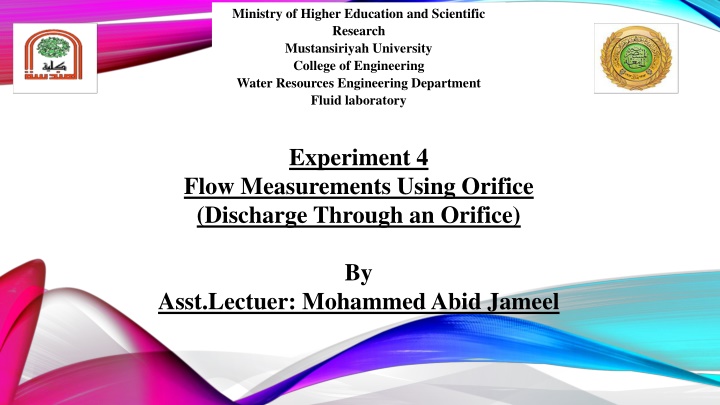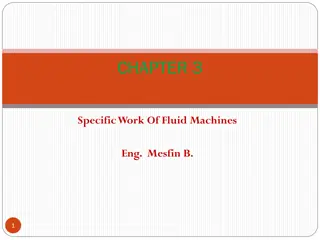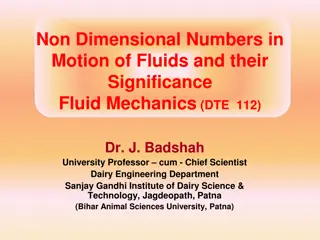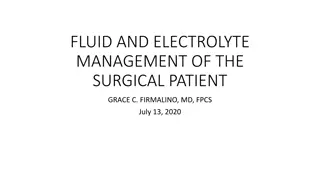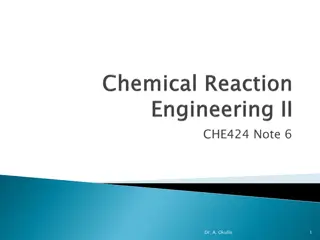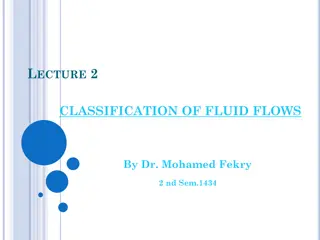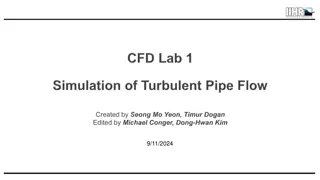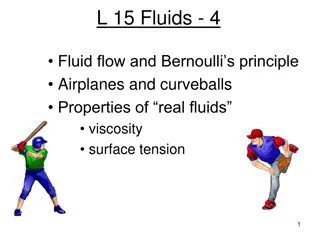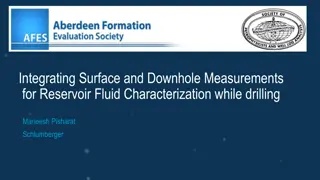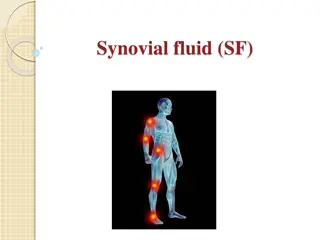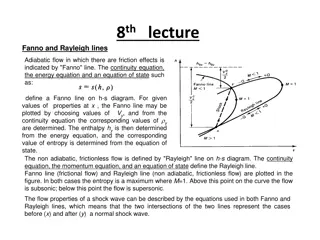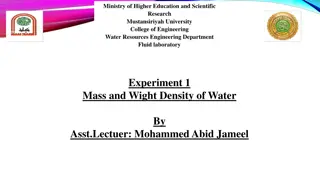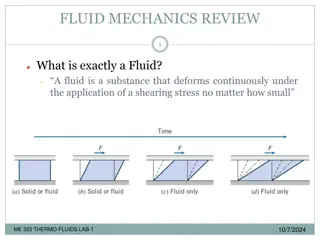Flow Measurements Using Orifice: Experiment in Fluid Laboratory
Understanding the principles of flow measurement through an orifice meter is essential in engineering. This experiment aims to determine the discharge coefficient of an orifice meter, analyzing the theoretical aspects and addressing sources of error such as mechanical losses and the vena contracta. The practical application involves measuring the pressure difference across the orifice to calculate flow rate. By exploring the secondary flows and vena contracta phenomenon, students gain insights into flow measurement accuracy and the importance of the discharge coefficient.
Download Presentation

Please find below an Image/Link to download the presentation.
The content on the website is provided AS IS for your information and personal use only. It may not be sold, licensed, or shared on other websites without obtaining consent from the author.If you encounter any issues during the download, it is possible that the publisher has removed the file from their server.
You are allowed to download the files provided on this website for personal or commercial use, subject to the condition that they are used lawfully. All files are the property of their respective owners.
The content on the website is provided AS IS for your information and personal use only. It may not be sold, licensed, or shared on other websites without obtaining consent from the author.
E N D
Presentation Transcript
Ministry of Higher Education and Scientific Research Mustansiriyah University College of Engineering Water Resources Engineering Department Fluid laboratory Experiment 4 Flow Measurements Using Orifice (Discharge Through an Orifice) By Asst.Lectuer: Mohammed Abid Jameel
1. Introduction: There are many situations in the engineering field where it is necessary to know the flowrate in a pipe. There are various flow-measuring devices that all determine the flow rate in a pipe but the most common is the obstruction-type flowmeter. Obstruction flowmeters operate on the idea that a decrease in flow area in a pipe causes an increase in velocity that in turn decreases pressure. This correlation of pressure difference and velocity provides the means of measuring flowrate. The different obstruction-type flowmeters consist of the orifice meter, the nozzle meter, and the Venturi meter. In this lab we will be measuring the flow through an orifice meter. A schematic of a standard orifice meter can be seen below in Figure 1. Figure 1. Schematic of Standard Orifice Meter
2. Objectives: To determine the discharge coefficient of orifice meter. 3. Theoretical Aspects (equations): 3.1. Theoretical background: An orifice meter is defined to be a plate having a central hole that is placed across the flow of a liquid, usually between flanges in a pipeline. The pressure difference generated by the flow velocity through the hole enables the flow quantity to be measured. As seen in Figure 1 the fluid flows through the left side of the pipe at the pipe diameter D1 and it is restricted down to D2 as it flows through the restricting plates, this is known as the orifice. The pressure difference is measured at P1 and P2. This pressure can be measured using any different measurement devices such as piezometer tubes or pressure gages.
Figure 2. Illustration of Secondary Flows and Vena Contract That Occurs in Orifice Meter
The vena contracta is the location of the smallest cross-sectional diameter of the flow of liquid after the orifice of the meter. This is also shown in Figure 2 above. This Secondary flows phenomenon is the result of the inability of the fluid to turn the sharp 90 degree corner formed by the orifice plates. Some common properties of the vena contracta are: constant pressure across the cross-sectional area and all the streamlines of flow are parallel at this location (Fundamentals of Fluid Mechanics). To calculate the theoretical flow rate through the meter you multiply the velocity of the fluid by the area of the orifice. This value unfortunately will not match the actual flow rate through the orifice of the meter. This is due to two main sources of error. The first is the mechanical losses due to friction along the walls of the meter. The second is the reduction in area of flow due to the vena contracta phenomenon discussed above. To account for these sources of error, a discharge coefficient is introduced into the calculation. According to TheEngineeringToolBox.com a standard value for the discharge coefficient of an orifice meter is 0.6.
3.2. The Equations: Vo = (2 ??o)1/2 (1) Where: Vo= the ideal velocity (m/sec). ?o= the height of the water from the top of the tank to the vena contract (mm). Vc = (2 ??c)1/2 ..(2) Where: Vc= the actual velocity (m/sec). ?c= the water level in the Pitot tube measured from the stagnation point (mm). Cv= Vc / Vo= (2 ??c /2 ??o)1/2 (3) Where: Cv= the coefficient of velocity. Cc= ac / ao .(4) Where: Cv= the coefficient of contraction. ao= the ideal area of the orifice (mm2). ao=?/4do2 ac= the actual area of water which flowing through the vena contracta (mm2). ac =?/4dc2
Thus the equation (4) can be simplified to: Cc= (dc /do)2 .(5) do= the ideal diameter of flow (the diameter of the orifice) (mm). dc= the actual diameter of flow (the diameter of vena contracta) (mm). dc= dout + din /2 ..(6) Where: dout = the outer diameter of jet (mm). din = the inner diameter of jet (mm). Qideal = Vo ao ..(7) Qactual = Vc ac ..(8) Qactual = Cv Vo Cc ao ..(9) Qactual = Cv Cc Qideal ..(10) Cd = Cv Cc ..(11) Where: Cd = the coefficient of discharge. (Figure 3).
4. Experimental Work: 4.1. Equipment and apparatus: The experience consist of the device and tools following, (Figures 4): 1- The orifice meter. 2- Measuring tank. 3- Stopwatch. Cylindrical glass tank Piezometer tubs Figuer 4. The Orifice Meter Used in the Experiment
4.2. Procedure: 1. Measure the (Qact) by recording the time for takes the fixed volume of water in measuring tank, such as, (10, and 15 Liter). 2. Measure (Ho, and Hc) by using piezometer tubes in orifice meter. 3. Measure the diameter of jet at the vena contract (dc) by measuring (dout, and din) by using the blade on the Pitot tube assembly. In Figure (4), there is a measurement dial that controls the horizontal movement of the blade. 4.3. Data Sheet: The table (1) below is the data sheet for this experiment: Table (1). The Date Sheet Ho (mm) (mm) Vol (L) Time (sec) Hc do dout (mm) din dc Ran (mm) 19 19 (mm) (mm) 1 2
5. Calculations and Results: For calculating the results for this experiment, we follow the following steps: 1. Calculate Qact by using equation (Qact=Vol/time). 2. Calculate Vo and Vc by using equations (1, and 2). 3. Calculate Cv by using equations (3). 4. Calculate ao and ac by using equation (a=?/4d2). 5. Calculate Cc by using equation (4 or 5). 6. Calculate Cd by using equation (10). 7. Calculate Cd (again) by using equation (11). 8. Plot the relationship between piezometer tube height (Ho1/2) (m1/2) and the actual discharge Qact (Qact x104) (m3/sec). The table (2) is represent the results for this experiment: Table (2). The Experiment Results Ran Qact (m3/sec) Vo (m/sec) Vc (m/sec) Cv Cc Cd Cd Eq 10 Eq 11 1 2
6. Discussion: 1. Is there a difference between the values of Qideal calculated by equation (7) and Qact by using equation (Qact=Vol/time)? Why? 2. Is there a difference between the values of Qact calculated by equation (8) and Qact by using equation (Qact=Vol/time)? Why? 3. Is there a difference between the values of the ideal diameter and the actual diameter? Why? 4. Is there a difference between the values of Cd calculated by equation (10) and Cd by using equation (11)? Why? 5. What is the relationship type in the plot between the water height in piezometer tube (Ho) and the actual discharge Qact? Why?
Thnke you Thank you
